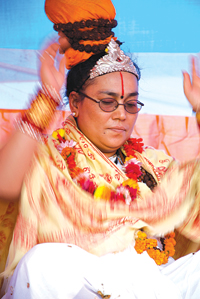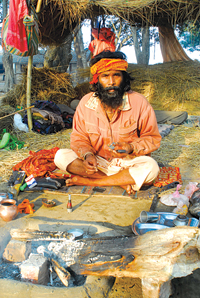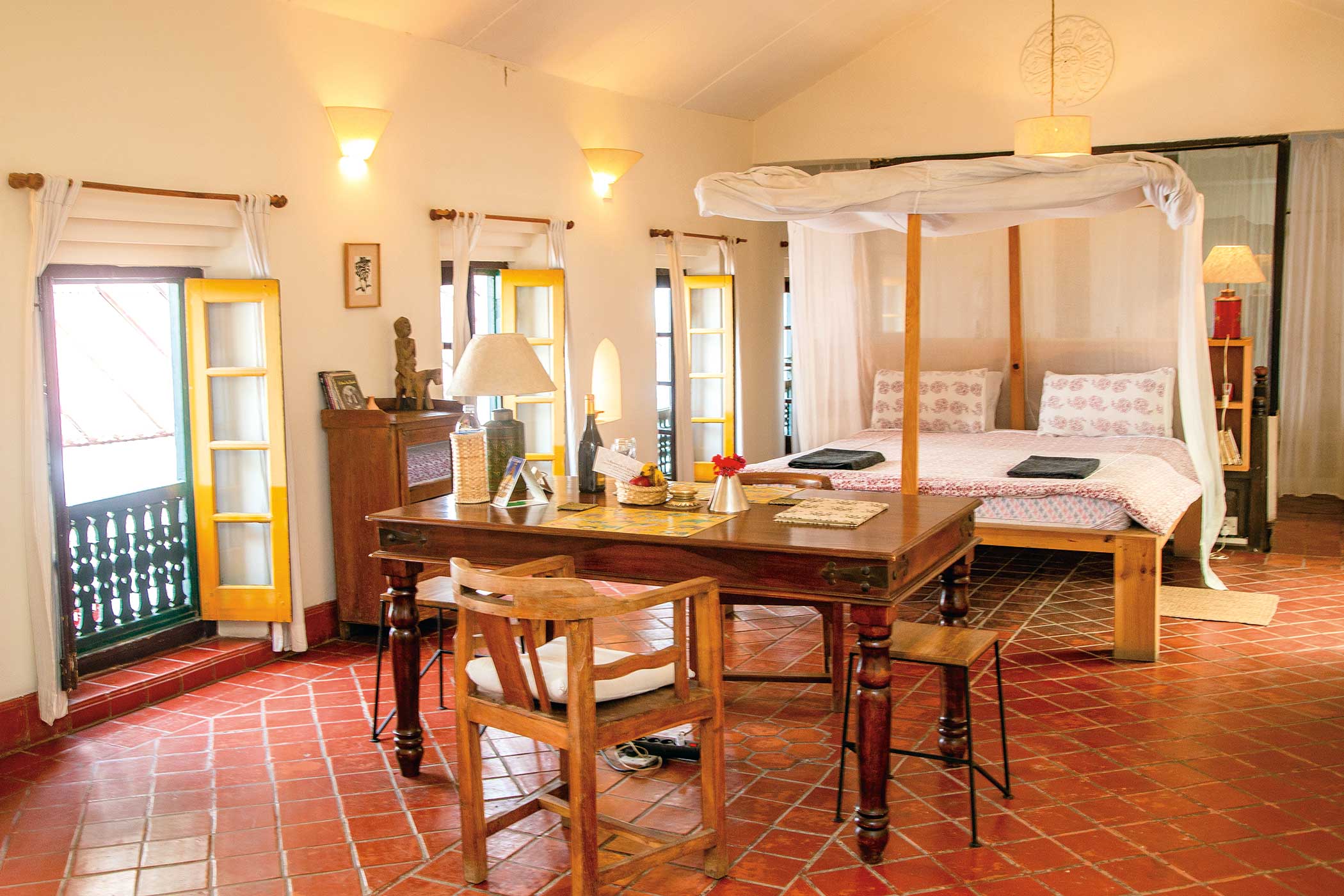Around the hallowed streets of Kathmandu, it’s impossible to not notice countless temples, statues, ponds and holy-places for worshipping the divine’s various forms and energies. Morning’s pre-light unveils hosts of the devout moving with direction and passion, carrying gifts of flowers, water and vermillion powder in hand. They move to perform sacred ageless oblations and worships, to give thanks for life and to ask for assistance from above.
 Yet, when looked upon more closely, one will notice that the lines of the devout are not so widespread, mostly towards major complexes like the valley’s three Durbar Squares, to the home of Lord Pashupathinath and some other select sites. Upon further observations one notices that the devout are predominately from older generations.
Yet, when looked upon more closely, one will notice that the lines of the devout are not so widespread, mostly towards major complexes like the valley’s three Durbar Squares, to the home of Lord Pashupathinath and some other select sites. Upon further observations one notices that the devout are predominately from older generations.
Wherever Oh Wherever…
As one who regularly stays at small temples and holy grounds I often find myself at ritual times —especially mornings and evenings—pondering where the devout are? Where are the devotees to pour offerings over Lord Shiva’s lingam (phallic statue)? Where are the holy men to man the sacred dhuni or fire: a doorway to mother earth, used for performing sacred rituals and to make offerings. Who is there to ring temples’ bells—sources of the auspicious Om—and, where are the priests to perform Aarti Puja: the offering of light? Such rituals are meant for the good of all society, keeping universal balances and harmony.
Numbers are dropping; Pujaris (temple priests), Babas (renouncers, keepers of tantric practices) and Karmachariyas (performers of selfless services) are all on the wane. If you don’t believe me, go see how many temples are missing the touch of tender love and devotion.
Why is it so? Well, this is too big a question to ask in these few pages, probably it’s connected with the modern world, where people “don’t have time” to give, for we chase personal success and careers like never before. Others say that it’s the cause of politics, while others voice karmic reasoning.
But wait, all is not lost, not even close.
de nouveau—adverb; starting again from the beginning, anew.
My wanderings through Nepal searching for great Gurus or teachers led me far and wide and usually in vain. Yet one area has stood out in my heart, impressed me and even brought tears to my eyes. Along the Tarai’s flatlands, specifically the districts of Tanahu, Makwanpur, Bara and Dhanusa, I have found communities active in their devotion, where temples are being expanded, restored and built new; with knowing-Gurus coming from far and wide.
Nepal is a different place in these locations, removed from its clichéd Himalayan settings—this is jungle a rea not mountainous. Here the Nepalese language doesn’t get you much further than creating confusion; Hindi, Mithali, Bhojpuri and Bihari are the languages heard in local teashops, bus-stops and temples.
rea not mountainous. Here the Nepalese language doesn’t get you much further than creating confusion; Hindi, Mithali, Bhojpuri and Bihari are the languages heard in local teashops, bus-stops and temples.
Yet other sounds stand out for one’s attention, especially in the mornings: hand-pumps spouting water for devotees’ pre-morning oblations, while mantras flow from holy men moving with purpose and temple bells ring out their Om’s.
Go to Birgunj—a town often overlooked—count the numbers moving with gifts for deities at temples to Durga Devi, Hanuman and Lord Shiva’s Alekhiamuth temple. Here people carry certain flavors in their habits—different from those of Kathmandu.
Visit Janakpur in Dhanusa District and its many temples to the divine-couple Sita-Ram. See devotees move in pre-morning light to wash their bodies in its 52 holy ponds, before worshipping at its temples. Few times are better to visit and feel this place than the festival of Vivaha Panchami celebrating Sita-Ram’s wedding, in the month of November(-ish).
Visit the once in five-year festival to Gadi-Mai Devi, with a near infinite amount of bloody offerings given to this—the darkest—avatar of the fearsome goddess Kali. During the 2010 festival, half a million animals were sacrificed in a month, making it the world’s bloodiest slaughter. For those with soft constitutions, this may not be a place for you. However it is a most serene location any other time, sitting in the middle of nowhere, surrounded only by rice fields.
Try joining the mass worship of the sun during August’s Chaath-Puja, where all communities go as one to rivers and ponds with bounties of colorful fresh fruits and water as gifts to our principal and original giver of life. Together the people pray for prosperity, good fortune, health and to give thanks for what has been and what will be.
Then there is the amazing meeting point of the Kali Gandaki and Trishuli Rivers in Devghat. Yogis and holy men have long meditated and worshipped at this auspicious confluence. The Kali Gandaki is seen as the very personification of Lord Vishnu - King of Gods and the Trishuli as Lord Shiva - Destroyer of Illusions. It’s also a place where Hindu gods and goddesses such as Lord Krishna and Lord Rama bathed and worshipped. Legends tell that even the Goddess Sita was cremated here. Today it is a place where aged Hindus come to live out their final years in meditation with every second building being a temple or ashram accommodating these practices.
 Building upwards
Building upwards
I sit with Sita-Ram Baba at his ashram in Jeetpur, on the highway between Hetauda and Birgunj. This was his Guru’s place: Sri 108 Bengali Baba. Sita-Ram’s most common phrase to me is “How can we make a success? How to get food to eat and fuel for the dhuni and aarti?” His answer has been to grow and sell fruit to make up the difference, keeping his Guru’s ashram going.
Guru-ji had the foresight to plant numerous mango, banana and lemon trees around his ashram’s temples, which today have matured to a fine size, giving good yields. Without this Sita-Ram Baba’s ashram could be a very different story. He manages to feed those who come through, buy material for rituals and keep his dhuni going. In effect, he is keeping the show going.
Here, morning and evening Aarti-Puja ceremonies are a joyous affair, performed with devotion by the temple’s Babas and devotees together; a harmonious counterbalance to the highway passing just outside its entrance and the steel factory that works day and night behind.
Baba takes me to meet Ghani Das Baba from India’s Manali District who is building a new ashram behind Birgunj. He is halfway through making a vast area or compound for holy men to be and to continue their practices in peace, supported by foods they grow themselves. His face gives the impression of a man on a mission. Ghani Das does not partake in the ritual of smoking a chillum, he has things to do and you can see a focused mind at work in this holy man. As I leave his company, he says to me: “You are a Baba, this place is for you and all Babas to be, to live and to practice, you have no worries here.”
Friends in the night
I first ended up in this part of the country some years ago on a quest to find Shambu Das Baba, a fully correct Sita-Ram Baba I met on the pilgrims-road to icy Gosaikunda Lake in the high Himalayas. He had invited me to visit his temple in the deep jungles of Birgunj.
 Naturally, when trying to find this Baba in such a random location I got lost in my quest, ending up in the village of Bindabasani. Arriving in the dead of night, a devotee took me to the jungle-hut of a group of Naga-Babas outside the village’s bazaar.
Naturally, when trying to find this Baba in such a random location I got lost in my quest, ending up in the village of Bindabasani. Arriving in the dead of night, a devotee took me to the jungle-hut of a group of Naga-Babas outside the village’s bazaar.
I met Bom Bom Giri Naga-Baba—not much older than me—a builder of nine temples in India and Nepal to the Goddess Durga. Seeing they were without a dhuni, the Italian Baba with whom I was travelling and I set ourselves to task: to thank the community for their hospitality. Within moments of completion, the village’s devotees came to give their respect. Words of Baba Dhanyabad (thank you) are all I could decipher. Soon numbers multiplied to worship at this newest doorway into Mother Earth.
Those coming from the jungle with timber-loaded bicycles for city destinations each left a gift for the fire’s continuation. Milkmen stopped on their way to the market, each offering a glass for the dhuni and its Gurus, while farmers left vegetables. On top of their generosity, each took a moment at the fire, to receive its blessings.
Bom Bom said to me with smiling grace, “The world revolves around the dhuni, we only man it, it gives all that we need, no more, no less.”
Reunited and repairing
Further down Bindabasani’s dusty jungle-trail, six months’ later, I would finally find Shambu Das Baba, the long lost Guru I originally quested for. Then, I was being hosted by a rather-rude Mahanta (temple priest) in the jungle village of Boudatar, when Shambu Das heard of the arrival of two foreign Babas. He instantly knew one must have been his friend, whom he had long awaited. Soon we were whisked away… oh what joy seeing my long lost friend, an impressive working Baba and someone I could at least communicate with—in Nepalese.
 Seeing this Baba removed from the mountain-trail where I first met him, at his temple in the jungle, a deep respect grew for this “Guru”. Being Mongolian of face sets him apart from the local descendants of Indian lands and Shambu Das revels in it. He would jovially only speak Nepalese to them, “I am Nepali and this is Nepal.” His temple was crumbling around him and when asked how he came to be here his answer was simple: “I was walking along the trail one day, came upon it and knew I had to be here. So I work making the daily rituals and slowly build it back up.”
Seeing this Baba removed from the mountain-trail where I first met him, at his temple in the jungle, a deep respect grew for this “Guru”. Being Mongolian of face sets him apart from the local descendants of Indian lands and Shambu Das revels in it. He would jovially only speak Nepalese to them, “I am Nepali and this is Nepal.” His temple was crumbling around him and when asked how he came to be here his answer was simple: “I was walking along the trail one day, came upon it and knew I had to be here. So I work making the daily rituals and slowly build it back up.”
It is a Sita-Ram Temple and he is a Sita-Ram Baba, in a village with three other Sita-Ram temples. Yet Shambu Das’s pump is the first to be heard in the mornings at half past three and his puja bell is the first that is rung. He sets himself the standard of being a working Baba, not an asking one. The village of strong devotees sees and respects this Baba at work; by this act alone the temple gets supported and repaired piece by piece.
Resurgence
Whatever the reasoning behind the differences in the valley and the Tarai - wealthier bank balances, different communities or the simple switches and changes of life - parts of the Tarai are becoming a safe haven for Sanathan Dharma or the saintly way. Sure, many temples are still falling down and others empty, but a fresh injection of life can be viewed in large swathes.
When talking with Babas and holy men who have lived their ages in Kathmandu, they convey feelings of sadness for the way things have gone. The holy Bagmati River has regressed on such a large scale that it has made many riverside temples redundant. Also, it seems that in Kathmandu the old monarchy system played a personal role in providing temples’ needs, via its Guthi system: community organizations that care for the needs of each temple besides other social works.
Other factors to consider are years of civil strife where religion became a decisive issue and a long line of fake holy men and weak priests who took advantage of people and situations—which certainly didn’t help opinions.
Nonetheless, there now seems to be a place for holy men and devotees to be as they were meant to. The ways of Sanathan Dharma continues with people helping and doing what is required. In many ways, these Tarai areas are a separate part of the country, one often difficult in habits and environment. Yet, in the line of the Hindu religion, they are at the forefront of what could be a great renaissance in its education, practices and knowledge.
Charlie Das Udasin is a Bhakta with love for revivals. Contact at charliedasudasin@gmail.com.











